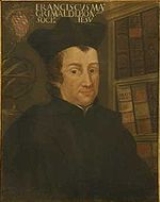
Francesco Maria Grimaldi
Encyclopedia
Francesco Maria Grimaldi (2 April 1618 – 28 December 1663) was an Italian Jesuit priest, mathematician
Mathematician
A mathematician is a person whose primary area of study is the field of mathematics. Mathematicians are concerned with quantity, structure, space, and change....
and physicist
Physicist
A physicist is a scientist who studies or practices physics. Physicists study a wide range of physical phenomena in many branches of physics spanning all length scales: from sub-atomic particles of which all ordinary matter is made to the behavior of the material Universe as a whole...
who taught at the Jesuit college in Bologna
Bologna
Bologna is the capital city of Emilia-Romagna, in the Po Valley of Northern Italy. The city lies between the Po River and the Apennine Mountains, more specifically, between the Reno River and the Savena River. Bologna is a lively and cosmopolitan Italian college city, with spectacular history,...
.
Between 1640 and 1650, working with Riccioli, he investigated the free fall
Free fall
Free fall is any motion of a body where gravity is the only force acting upon it, at least initially. These conditions produce an inertial trajectory so long as gravity remains the only force. Since this definition does not specify velocity, it also applies to objects initially moving upward...
of objects , confirming that the distance of fall was proportional to the square of the time taken. Grimaldi and Riccioli also made a calculation of the gravitational constant by recording the oscillations of an accurate pendulum.
In astronomy
Astronomy
Astronomy is a natural science that deals with the study of celestial objects and phenomena that originate outside the atmosphere of Earth...
, he built and used instruments to measure lunar mountains as well as the height of clouds, and drew an accurate map or, selenograph, which was published by Riccioli and now adorns the entrance to the National Air and Space Museum in Washington D.C.
He was the first to make accurate observations on the diffraction
Diffraction
Diffraction refers to various phenomena which occur when a wave encounters an obstacle. Italian scientist Francesco Maria Grimaldi coined the word "diffraction" and was the first to record accurate observations of the phenomenon in 1665...
of light
Light
Light or visible light is electromagnetic radiation that is visible to the human eye, and is responsible for the sense of sight. Visible light has wavelength in a range from about 380 nanometres to about 740 nm, with a frequency range of about 405 THz to 790 THz...
(although by some accounts Leonardo da Vinci
Leonardo da Vinci
Leonardo di ser Piero da Vinci was an Italian Renaissance polymath: painter, sculptor, architect, musician, scientist, mathematician, engineer, inventor, anatomist, geologist, cartographer, botanist and writer whose genius, perhaps more than that of any other figure, epitomized the Renaissance...
had earlier noted it), and coined the word 'diffraction'. Through experimentation he was able to demonstrate that the observed passage of light could not be reconciled with the idea that it moved in a rectilinear path. Rather, the light that passed through the hole took on the shape of a cone. Later physicists used his work as evidence that light was a wave, and Isaac Newton
Isaac Newton
Sir Isaac Newton PRS was an English physicist, mathematician, astronomer, natural philosopher, alchemist, and theologian, who has been "considered by many to be the greatest and most influential scientist who ever lived."...
used it to arrive at his more comprehensive theory of light. He also discovered what are known as diffraction bands.
The crater Grimaldi
Grimaldi (crater)
Grimaldi is a large basin located near the western limb of the Moon. It lies to the southwest of the Oceanus Procellarum, and southeast of the crater Riccioli...
on the Moon
Moon
The Moon is Earth's only known natural satellite,There are a number of near-Earth asteroids including 3753 Cruithne that are co-orbital with Earth: their orbits bring them close to Earth for periods of time but then alter in the long term . These are quasi-satellites and not true moons. For more...
is named after him.
Publications
- Physicomathesis de lumine, coloribus, et iride, aliisque annexis (published 1665)
External links
- Catholic Encyclopedia article for Francesco Maria Grimaldi.

